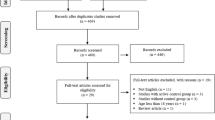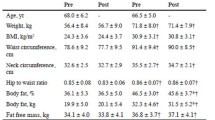Abstract
Background
Irisin is a newly discovered hormone that is proposed to be a promising therapeutic target in obesity and type 2 diabetes. It has received remarkable attention recently, while inconsistent results have been shown regarding its association with chronic exercise training in adults.
Objective
The aim of this study was to evaluate the effects of chronic exercise training on circulating (plasma/serum) irisin in adults by meta-analyzing randomized controlled trials (RCTs) and non-randomized studies (NRSs) separately.
Methods
We conducted a search of the PubMed, Web of Science and Cochrane Library databases from January 2012 to September 2014 for studies published in English. Studies were included if they had an assessment of chronic (≥8 weeks) exercise training effects on circulating irisin in the general or clinical population (mean age ≥18 years) with reported outcomes of circulating irisin, and involved more than five participants. Pooled effect sizes (Cohen’s d) with 95 % confidence intervals (CIs) for changes in circulating irisin were calculated by a random-effects model. Subgroup analyses were performed to evaluate the association between exercise modes and changes in circulating irisin.
Results
Of the 181 articles screened, 12 studies in eight articles were included, of which three were RCTs and nine were NRSs. In the three RCTs (a total of 173 healthy, untrained participants), chronic exercise training was associated with a moderate and significant overall effect in decreasing circulating irisin compared with the control (d = −0.46; 95 % CI −0.76 to −0.15). Chronic resistance exercise training showed a moderate and significant effect in decreasing circulating irisin compared with the control (d = −0.41; 95 % CI −0.75 to −0.06), while endurance exercise training only had a trend (d = −0.64; 95 % CI −1.32 to 0.04). In the nine NRSs (a total of 113 intervention participants), chronic exercise training was associated with a trivial and non-significant overall effect in decreasing circulating irisin compared with baseline (d = −0.04; 95 % CI −0.30 to 0.23).
Conclusions
Chronic exercise training leads to significantly decreased circulating irisin levels in the RCTs, while evidence remains inconclusive in the NRSs. Well-designed RCTs that measure dietary intake and report changes of body fat percentage or insulin sensitivity/resistance index following chronic exercise training are required to confirm these findings.



Similar content being viewed by others
References
Boström P, Wu J, Jedrychowski MP, et al. A PGC1-alpha-dependent myokine that drives brown-fat-like development of white fat and thermogenesis. Nature. 2012;481(7382):463–8.
Polyzos SA, Kountouras J, Shields K, et al. Irisin: a renaissance in metabolism? Metabolism. 2013;62(8):1037–44.
Sanchis-Gomar F, Lippi G, Mayero S, et al. Irisin: a new potential hormonal target for the treatment of obesity and type 2 diabetes. J Diabetes. 2012;4(3):196.
Wang L, Mascher H, Psilander N, et al. Resistance exercise enhances the molecular signaling of mitochondrial biogenesis induced by endurance exercise in human skeletal muscle. J Appl Physiol (1985). 2011;111(5):1335–44.
Huh JY, Mougios V, Kabasakalis A, et al. Exercise-induced irisin secretion is independent of age or fitness level and increased irisin may directly modulate muscle metabolism through AMPK activation. J Clin Endocrinol Metab 2014;99(11):E2154–61.
Pardo M, Crujeiras AB, Amil M, et al. Association of irisin with fat mass, resting energy expenditure, and daily activity in conditions of extreme body mass index. Int J Endocrinol. 2014;2014:857270.
Hecksteden A, Wegmann M, Steffen A, et al. Irisin and exercise training in humans: results from a randomized controlled training trial. BMC Med. 2013;11:235.
Scharhag-Rosenberger F, Morsch A, Wegmann M, et al. Irisin does not mediate resistance training-induced alterations in resting metabolic rate. Med Sci Sports Exerc. 2014;46(9):1736–43.
Moraes C, Leal VO, Marinho SM, et al. Resistance exercise training does not affect plasma irisin levels of hemodialysis patients. Horm Metab Res. 2013;45(12):900–4.
Huh JY, Panagiotou G, Mougios V, et al. FNDC5 and irisin in humans: I. Predictors of circulating concentrations in serum and plasma and II. mRNA expression and circulating concentrations in response to weight loss and exercise. Metabolism. 2012;61(12):1725–38.
Norheim F, Langleite TM, Hjorth M, et al. The effects of acute and chronic exercise on PGC-1α, irisin and browning of subcutaneous adipose tissue in humans. FEBS J. 2014;281(3):739–49.
Elbelt U, Hofmann T, Stengel A. Irisin: what promise does it hold? Curr Opin Clin Nutr Metab Care. 2013;16(5):541–7.
Hofmann T, Elbelt U, Stengel A. Irisin as a muscle-derived hormone stimulating thermogenesis: a critical update. Peptides. 2014;54:89–100.
Moher D, Liberati A, Tetzlaff J, et al. Preferred reporting items for systematic reviews and meta-analyses: the PRISMA statement. Ann Intern Med. 2009;151(4):264–9.
Higgins JPT, Green S (editors). Cochrane handbook for systematic reviews of interventions version 5.1.0 [updated March 2011]. The Cochrane Collaboration; 2011. Available from: http://www.cochrane-handbook.org. Accessed 10 Sep 2014.
Cohen J. Statistical power analyses for the behavioral sciences. 2nd ed. New York: Erlbaum; 1988.
Pekkala S, Wiklund PK, Hulmi JJ, et al. Are skeletal muscle FNDC5 gene expression and irisin release regulated by exercise and related to health? J Physiol. 2013;591(Pt 21):5393–400.
Kurdiova T, Balaz M, Vician M, et al. Effects of obesity, diabetes and exercise on Fndc5 gene expression and irisin release in human skeletal muscle and adipose tissue: in vivo and in vitro studies. J Physiol. 2014;592(Pt 5):1091–107.
Ellefsen S, Vikmoen O, Slettalokken G, et al. Irisin and FNDC5: effects of 12-week strength training, and relations to muscle phenotype and body mass composition in untrained women. Eur J Appl Physiol. 2014;114(9):1875–88.
Moreno-Navarrete JM, Ortega F, Serrano M, et al. Irisin is expressed and produced by human muscle and adipose tissue in association with obesity and insulin resistance. J Clin Endocrinol Metab. 2013;98(4):E769–78.
Roca-Rivada A, Castelao C, Senin LL, et al. FNDC5/irisin is not only a myokine but also an adipokine. PLoS One. 2013;8(4):e60563.
Miller WC, Koceja DM, Hamilton EJ. A meta-analysis of the past 25 years of weight loss research using diet, exercise or diet plus exercise intervention. Int J Obes Relat Metab Disord. 1997;21(10):941–7.
Pimenta NM, Santa-Clara H, Sardinha LB, et al. Body fat responses to a 1-year combined exercise training program in male coronary artery disease patients. Obesity (Silver Spring). 2013;21(4):723–30.
Park KH, Zaichenko L, Brinkoetter M, et al. Circulating irisin in relation to insulin resistance and the metabolic syndrome. J Clin Endocrinol Metab. 2013;98(12):4899–907.
Sesti G, Andreozzi F, Fiorentino TV, et al. High circulating irisin levels are associated with insulin resistance and vascular atherosclerosis in a cohort of nondiabetic adult subjects. Acta Diabetol. 2014;51(5):705–13.
Garces MF, Peralta JJ, Ruiz-Linares CE, et al. Irisin levels during pregnancy and changes associated with the development of preeclampsia. J Clin Endocrinol Metab. 2014;99(6):2113–9.
Al-Daghri NM, Alkharfy KM, Rahman S, et al. Irisin as a predictor of glucose metabolism in children: sexually dimorphic effects. Eur J Clin Invest. 2014;44(2):119–24.
Conn VS, Koopman RJ, Ruppar TM, et al. Insulin sensitivity following exercise interventions: systematic review and meta-analysis of outcomes among healthy adults. J Prim Care Community Health. 2014;5(3):211–22.
Lopez-Legarrea P, de la Iglesia R, Crujeiras AB, et al. Higher baseline irisin concentrations are associated with greater reductions in glycemia and insulinemia after weight loss in obese subjects. Nutr Diabetes. 2014;4:e110.
de la Iglesia R, Lopez-Legarrea P, Crujeiras AB, et al. Plasma irisin depletion under energy restriction is associated with improvements in lipid profile in metabolic syndrome patients. Clin Endocrinol (Oxf). 2014;81(2):306–11.
Anastasilakis AD, Polyzos SA, Saridakis ZG, et al. Circulating irisin in healthy, young individuals: day–night rhythm, effects of food intake and exercise, and associations with gender, physical activity, diet, and body composition. J Clin Endocrinol Metab. 2014;99(9):3247–55.
Scalzo RL, Peltonen GL, Giordano GR, et al. Regulators of human white adipose browning: evidence for sympathetic control and sexual dimorphic responses to sprint interval training. Plos One. 2014;9(6):e90696.
Thompson SG, Higgins JPT. How should meta-regression analyses be undertaken and interpreted? Stat Med. 2002;21(11):1559–73.
Raschke S, Elsen M, Gassenhuber H, et al. Evidence against a beneficial effect of irisin in humans. Plos One. 2013;8(9):e73680.
Al-Daghri NM, Al-Attas OS, Alokail MS, et al. Maternal inheritance of circulating irisin in humans. Clin Sci (Lond). 2014;126(12):837–44.
Lee P, Linderman JD, Smith S, et al. Irisin and FGF21 are cold-induced endocrine activators of brown fat function in humans. Cell Metab. 2014;19(2):302–9.
Zhang HJ, Zhang XF, Ma ZM, et al. Irisin is inversely associated with intrahepatic triglyceride contents in obese adults. J Hepatol. 2013;59(3):557–62.
Liu JJ, Wong MDS, Toy WC, et al. Lower circulating irisin is associated with type 2 diabetes mellitus. J Diabetes Complicat. 2013;27(4):365–9.
Stengel A, Hofmann T, Goebel-Stengel M, et al. Circulating levels of irisin in patients with anorexia nervosa and different stages of obesity: correlation with body mass index. Peptides. 2013;39:125–30.
Boström PA, Fernandez-Real JM, Mantzoros C. Irisin in humans: recent advances and questions for future research. Metabolism. 2014;63(2):178–80.
Acknowledgments
No specific grant or funding was received to conduct this study. The authors wish to acknowledge the help of Dr. Frode Norheim (University of Oslo, Oslo, Norway), Dr. Satu Pekkala (University of Jyväskylä, Jyväskylä, Finland), Dr. Timea Kurdiova (Slovak Academy of Sciences, Bratislava, Slovak Republic), and Dr. Stian Ellefsen (Lillehammer University College, Lillehammer, Norway) for providing the raw data. Shanhu Qiu, Xue Cai, Zilin Sun, Uwe Schumann, Martina Zügel, and Jürgen M. Steinacker have no conflicts of interest that are directly relevant to this study.
Author information
Authors and Affiliations
Corresponding author
Electronic supplementary material
Below is the link to the electronic supplementary material.
Rights and permissions
About this article
Cite this article
Qiu, S., Cai, X., Sun, Z. et al. Chronic Exercise Training and Circulating Irisin in Adults: A Meta-Analysis. Sports Med 45, 1577–1588 (2015). https://doi.org/10.1007/s40279-014-0293-4
Published:
Issue Date:
DOI: https://doi.org/10.1007/s40279-014-0293-4




